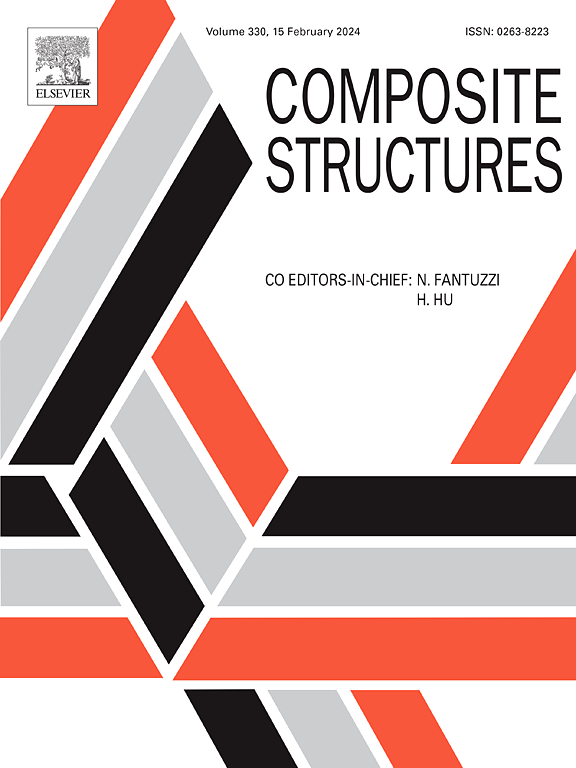时变热-力耦合条件下针刺碳/碳复合材料的超高温力学行为及显微组织演化
IF 6.3
2区 材料科学
Q1 MATERIALS SCIENCE, COMPOSITES
引用次数: 0
摘要
碳/碳(C/C)复合材料广泛应用于高超声速飞行器的热防护系统中,关键工艺信息的精确获取对于高超声速飞行器的可靠设计至关重要。因此,本研究引入了针刺C/C复合材料的高温重复加载测试方案,旨在表征再入飞行器在复杂热-力学耦合环境中的力学行为。首先,使用等离子喷涂和激光刻蚀技术制备了超高温散斑图案,该图案适合于本研究的温度范围(室温至2000°C)。然后,在时变的温度和载荷条件下,研究了局部应变场和拉伸性能。在单次加载试验中,在1500℃时,应力-应变曲线斜率下降了58%。在2000°C循环加载试验中,与标准试验相比,随着循环次数的增加,边坡增加了46%,而试件强度下降了27.1%。通过在宏观和微观尺度上检查断裂形态和内部结构,该研究阐明了界面性能和石墨化水平如何影响拉伸行为。结果表明:随着加载循环次数的增加,应力-应变曲线斜率主要受界面性能和碳纤维石墨化程度的影响,且在不同加载阶段,界面性能和碳纤维石墨化程度分别起主导作用;拉伸强度随加载次数的增加而降低,与界面性能呈正相关,与碳纤维石墨化成反比。本文章由计算机程序翻译,如有差异,请以英文原文为准。
Ultra-high temperature mechanical behavior and microstructural evolution of needle-punched carbon/carbon composites under time-varying thermo-mechanical coupling conditions
Carbon/carbon (C/C) composites are extensively employed in the thermal protection systems of hypersonic vehicles, and the precise acquisition of critical process information is vital for the reliable design of such vehicles. Consequently, this research introduces a high-temperature repeated loading testing protocol for needle-punched C/C composites, aimed at characterizing the mechanical behavior of re-entry vehicles in intricate thermal–mechanical coupling environments. Initially, an ultra-high-temperature speckle pattern was prepared using plasma spraying and laser etching techniques, which is suitable for the temperature range of this study (room temperature to 2000 °C). Subsequently, under time-varying temperature and load conditions, the local strain field and tensile properties were investigated. In the single-loading test, at 1500 °C, the stress–strain curve slope decreased by up to 58 %. In the cyclic loading test, at 2000 °C, the slope increased by up to 46 % with the number of cycles, while the specimen strength decreased by up to 27.1 % compared to the standard test. By examining fracture morphology and internal structure at both macroscopic and microscopic scales, the study elucidated how interfacial performance and the level of graphitization contribute to the tensile behavior. The results indicate that as the number of loading cycles increases, the stress–strain curve slope is primarily influenced by interfacial properties and carbon fiber graphitization, with each playing a dominant role at different loading stages. Additionally, tensile strength decreases with the rise in loading cycles, positively correlating with interfacial performance and inversely with carbon fiber graphitization.
求助全文
通过发布文献求助,成功后即可免费获取论文全文。
去求助
来源期刊

Composite Structures
工程技术-材料科学:复合
CiteScore
12.00
自引率
12.70%
发文量
1246
审稿时长
78 days
期刊介绍:
The past few decades have seen outstanding advances in the use of composite materials in structural applications. There can be little doubt that, within engineering circles, composites have revolutionised traditional design concepts and made possible an unparalleled range of new and exciting possibilities as viable materials for construction. Composite Structures, an International Journal, disseminates knowledge between users, manufacturers, designers and researchers involved in structures or structural components manufactured using composite materials.
The journal publishes papers which contribute to knowledge in the use of composite materials in engineering structures. Papers deal with design, research and development studies, experimental investigations, theoretical analysis and fabrication techniques relevant to the application of composites in load-bearing components for assemblies, ranging from individual components such as plates and shells to complete composite structures.
 求助内容:
求助内容: 应助结果提醒方式:
应助结果提醒方式:


